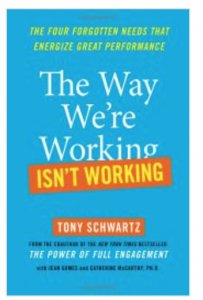The annual Solution Tree PLC Summit in late February was beyond awesome! If you were one of the 2100 school educators in attendance, there was a palpable energy and hopefulness in the conference over the three days. It was an honor to be a part of such a high-energy positive event with great colleagues and presenters.
And then I failed. Like anyone who takes a stage and teaches students and adults, from time to time we may not be at our very best in responding to a question, or presenting our thoughts in a helpful and hopeful way.
For me, it occurred during my response to a question during the day-2 panel session.
How do we respond to a colleague who just refuses to collaborate? Refuses to participate in the teams’ activities? Resists the use of high quality common assessments, the review of data from those assessments, reflect together on how to score assessments, and in general, does not want to discuss instruction elements with the team and at times is confrontational when attending the team?
That was the question.
And my response was pretty weak, and a bit short with the audience. This is atypical for me, so I was trying to figure out how I could have responded in a more helpful way, and of course it came to me, about 35 minutes later, and by then I was the only person left in the ballroom!
So, as part of a mea culpa, here is my improved response!
First, look at your teams’ conversations:
Confronting shortcomings and conflicts within the team requires a willingness to have tough conversations with certain people on the team. Tony Schwartz (2010) provides insight into the relational aspect of conflict:
Teachers and leaders who avoid conflict often cause more harm than those who are more direct. The key is to balance honesty with appreciation, always keeping in mind the value of the other person, even when being critical of a particular behavior. (p. 289)
John Kotter and Lorne Whitehead (2010) describe a framework for identifying three primary forms of verbal attacks often used by team members that can undermine the distribution and discussion of good ideas:
- We don’t need your idea, because the “problem” it solves doesn’t exist.
- Okay, the problem exists, but your solution isn’t a good one.
- Okay, a problem exists, and your solution is a good one, but it will never work here!
These “implicit attitudes of the attacker” (Kotter & Whitehead, 2010, p. 106) highlight typical communication attacks team members may unwittingly use. These responses assume that each idea is in competition with another, but in fact competing ideas can all be very good ideas.
The question for the team to focus on isn’t why any of the ideas won’t work. The question to answer is which of these ideas can serve the greater good—or is there a way to combine our ideas to better serve the greater good?
Notice how two of Kotter and Whitehead’s categories use the word but. This is one of the reasons we outlawed that word as part of our verbal conversations and replaced it with the word and. We wanted our PLC conversations to sound more like this: “Okay, that problem does exist, and how can we use your solution to also address the concern of [fill in the blank]?”
In a PLC culture, collaborative teams will work hard to take divergent thoughts from each member of the team, and combine them to make new and more meaningful ideas.
Second, embrace resistors to the vital PLC culture collaborative team behaviors:
Identify the Skeptics, Cynics and Opposers to the full implementation of the teams’ efforts! And then respond to them, based on why they are resisting.
- The Skeptic: Skeptics fear disappointing someone else or themselves. So they choose not to try. These are mostly the adults working from a fixed mindset for their abilities. The best remedy is to help them gain the confidence during the team time they need, to shift toward the vital behavior. How can you best help and support the current skeptics on your team?
- The Cynic: Cynics fear accepting responsibility and facing accountability to the vital behavior. There will be no one else to blame. The best remedy for the cynic is to have a strong PLC team. The social motivation of the team is the best way to influence the cynic. How can you best help and support the current cynics on your team, to diminish their fear?
- The Opposer: Opposers fear a changed power structure and removal of the status quo. They fear change itself and anything that disrupts the way they see the world. The best remedy for the opposer is to make the PLC culture become the status quo. How can you best “lean into” and support current opposers? One way to help opposers is to have a clear and established Conflict Resolution plan as outlined next.
Third, care enough to confront:
Every year there will be team conflict at some level. So, why not have a team adversity plan that kicks into action once conflict arose? We call this our “Care Enough to Confront” plan.
The plan consists of seven guidelines team members could follow because they cared enough to confront those not supporting the work of the team. We practice using the plan as an effective way to deal with the team adversity that is most assuredly going to occur every year!
- Confront ASAP: When a relational breakdown occurs between two people on the team, address the issues immediately. Further delay and unresolved issues only complicate the team dynamics.
- Separate the team member from the wrong action: Most team conflict issues are about a team member’s action that undermines the work of the team: for example, failure to be on time, failure to complete an assigned portion of the work project on time, failure to contribute in a positive manner, failure to act on an agreed-upon project or lesson assessment. It is the team member’s actions that need to be addressed, not the quality of the person.
- Give the team member the benefit of the doubt: It is important not to assume you know why the person was late, failed to deliver the project, or didn’t meet the deadline. Allow the person an opportunity to explain his or her actions.
- Avoid absolute words: Avoid using such words as always and never (“You always let the team down,” “You never show up on time,” “You never contribute to our team”). These types of statements are rarely true and diminish the speaker’s credibility.
- Avoid sarcasm: Do not use phrases such as “I know you just think you are too good for us” or “Maybe if you would try just a bit harder you could get it right next time” or “Well, our team knows what you’ll be doing while we work on this—nothing!”
- Tell the team member how you feel about what was done wrong: It is very important to let the team member know how his or her actions made you and/or the team feel. How does the action impact others? Often, offenders to the team norms and values do not fully realize the emotional wake they leave behind because of their actions or inactions in relation to team values and commitments.
- Keep a short account: Every team encounters some adversity as members debate and argue about important practices and methods for the teaching and learning. Once the care enough to confront discussion is completed, everyone on the team must let it go, move on, and keep a short mental account of the issue. Team members who harbor long-term resentments will be toxic to the team’s growth.
As the 2014-2015 season enters April, and this school year winds down, you can use some of these reflection tools to focus how your team might better embrace adversity in 2015-2016, answer the call of improving student learning, and solving the real and every day problems you face – together.
[author_bio id=”390″]










